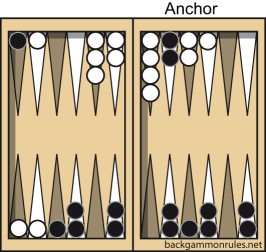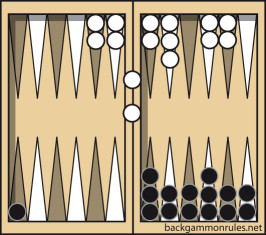Glossary
Accept a double
The game is continued at twice the previous stakes.
Anchor
A point occupied by two or more of your checkers in the opponent's inner table (home).
Back Game
A strategy for a player who is substantially behind in the race but has two or more anchors in the opponent's inner table (home). The back game player holds both anchors as long as possible thus making the opponent's bearing in or off awkward. The idea is to hit a blot and then contain the re-entered checker behind a prime.
Backgammon
1. The name of the game.
2. The loser has one or more checkers in the winner's inner table or on the bar. He pays the winner triple stakes.
Bar
Divides the board in the middle; provides space for hit checkers until they re-enter as well as for the doubling cube.
Bearing in
Moving a checker into the inner table (home) prior to bearing off.
Bearing off
Removing the checkers from the board after they all have been brought into one's inner table (home).
Blitz
Blocking all one's home points as quickly as possible to hinder the opponent from re-entering hit checkers.
Block (prime)
A wall of checkers on a number of consecutive points to block the opposing checkers behind it.
Blot
A single and therefore unprotected checker on one point.
Board
The board has 24 triangles (points), twelve on either side. The ones in front of a player are his inner and outer table (six points each). The ones on the other side are his opponent's tables. Inner and outer tables are divided down the center by the => Bar.
The U-shaped track for moving one's checkers starts on the opposing side of the board, which is the opponent's inner table. The two outer tables build the closed side of the U. The last quarter is one's own inner table, also known as home. See => Bearing off.
Break a block (prime)
Opening one or more points in a prime.
Break contact
Moving past the last of the opponent's checkers; since blocking and hitting are no longer possible, the game becomes a race.
Candlesticks
The player's checkers are piled high on a few points.
Chequer
British spelling of checker.
Closed board
All points are blocked in a player's inner table (home).
Compact or connected position
A position with several made points close to one another with few gaps. These positions are powerful because spare checkers can easily build new points and rear points can be broken safely.
Dice cup
A container used for shaking and rolling the dice.
Double hit
Hitting two opposing blots on one turn.
Doubling cube
Increases the stakes according to the numbers on its faces and higher.
Double
Two rolled dice with identical numbers on their upper faces; the values are doubled (four moves).
End game
Starts when either player begins to bear off.
Gammon
The loser has not removed any checker. He pays the winner double stakes.
Hit
Landing on a blot, removing it from the board and placing it on the bar. The opponent has to re-enter it to continue playing.
Home
Synonym for one's inner table.
Inner table
First and last quarters of the U-shaped track. The track starts in the opponent's inner table and ends in one's own. At the end of the game from here one starts removing the checkers.
Made point
A point covered with two or more checkers of one color. The opponent cannot land on such a point.
Making a point
Occupying a point with two or more checkers of one color.
Outer tables
The two quarters that form the closed side of the U-shaped track.
Pips
Numbers shown on the rolled dice.
Playing up
During the end game: using the rolled numbers not to remove checkers but to move them closer to the exit.
Point
Any of the 24 triangles on the board.
Prime
A wall of checkers on a number of consecutive made points to block opposing checkers behind the prime.
Re-enter
Bringing hit checkers back into the game. They are re-entered in the opponent's inner table.
Remove
see => Bear off
Six-point prime
A wall of checkers on six consecutive made points. Checkers behind the prime cannot pass until the prime is broken.
Stakes
The amount wagered by the players; the standard stake of one point can be doubled many times; see => Doubling cube.
Turn
The sequence of actions that each player takes in alternation. One turn consists of: (a) possibly offering a double; (b) rolling the dice; (c) playing the roll; and (d) picking up the dice.
Two-stage move
If both rolled numbers are applied to a single checker, the move actually consists of two separate ones, which requires an open intermediate point.
|







